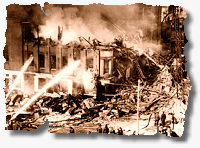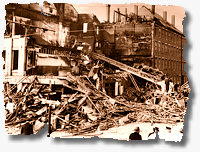Luongo Restaurant
Fire
15 Nov 1942
Luongo Restaurant Fire
--------------------------------------------------------------------------------
On November 15, 1942, six firefighters were killed, 43
injured, and many were trapped under debris for up to 18
hours. The story of the East Boston fire has been forgotten,
if not lost, by many, pushed off the front pages by the
terrible loss of life at the Cocoanut Grove only two weeks
later on November 28, 1942.
We all know of the Cocoanut Grove fire. The crowded nightclub,
the locked exits, the 492 victims, the trial, the changes
in the fire prevention codes that regulate decorations and
places of occupancies, and so forth. But what about the
fire two weeks earlier that killed six of our members and
injured so many more, some so severely that many never worked
on the job again.
 |
This is that story.
Across the street from the Maverick Square MBTA station
are the remnants of a great old building. For years
the building was known as the Old Amory Building.
The building was a second class wooden frame structure
of exterior masonry walls with exterior bearing walls,
three and a half stories high, about 120 by 40 feet
in area. Many political rallies were held there.. |
The fire started in the rear of Luongo's Restaurant, located
in the first floor of the hundred years old Maverick Lyceum.
A night worker discovered the fire. He told the firefighters
that an electric appliance caught fire. He ran into the
street and enlisted the aid of two citizens. They tried
in vain to fight the fire. Fire headquarters received a
call reporting the fire at 2:26 a.m. At 2:27 a.m. the East
Boston companies were notified and responded from their
fire station a few blocks away. The second alarm was sounded
at 3:04 a.m., when the fire seemed to be making headway.
The third alarm was sounded at 3:24 a.m.
Wall Collapsed Without Warning
Then at 4:15 a.m., without warning,the wall on the Henry
Street side of the building bulged and collapsed, trapping
firefighters in the building and burying Ladder 8. Fourth
and fifth alarms were sounded to help in the rescue effort
and to fight the fire which had gotten a fresh start after
the collapse. Within half an hour ambulance, doctors, additional
firefighters and rescue workers(including the Coast Guard)
were rushing to the scene. The scene was one of pandemonium.
Firefighters who were lucky enough to be clear of the wreckage,
although injured, made desperate efforts to save their comrades.
In the hours that followed, acts of heroism and bravery
unequaled in the history of the department were witnessed.
That more were not killed was due mostly to the gallant
actions of firefighters. Their own lives at stake, many
crawled into holes in the debris to pull their injured brothers
free.
 |
The Fire Spreads
As the rescue work was proceeding, the flames were
cracking high in the air. The adjoining building on
Henry Street caught fire and some fifty persons fled
in their night clothes. When daylight came, exhausted
and injured firemen were lying on the street, waiting
to be removed to hospitals. The quick arrival of doctors
and ambulances saved many lives. Without immediate
hospital treatment more than one injured fireman would
have died.
|
|
The firefighters who died were on the second floor working
with hose lines.
The saddest part of the tragedy was that the fire was "under
control" when the walls collapsed.
Great Ladder Smashed
The Department's 125 foot "jinx" aerial ladder,
reported to be the biggest in the nation at that time, was
standing beside the falling wall on Henry Street. It was
buried in the wreckage. The ladder was originally purchased
by the City of Somerville. They found upon delivery that
it was too big for their firehouse. Boston bought it. The
truck had a series of problems.
There was some speculation that due to the long ladder
and wide bed, the large ladder might have caused the wall
collapse. This theory was later ruled out. In fact, some
of the firefighters who were on the ladder at the time of
the collapse, credit the ladder bed with saving their lives.
When the granite and debris began falling, they lay down
in the bed and the rubble slid down over them to the street.
Many felt that this was the end to the ladder. But, it
was repaired and returned to service in South Boston as
Ladder 19. Tragedy would continue to haunt this piece of
apparatus. On December 3, 1947, Ladder 19 was out of service
conducting tests on its brakes when it overturned and rolled.
Provisional Firefighter Joseph B. Sullivan, on the job for
less than six months, was killed.
The Department took the truck out of service and scrapped
it. |



